Learn 7 easy ways to use a therapy ball to give your child a ton of sensory input! Plus, get the scoop on what different types of sensory balls are used for.
There are all sorts of sensory toys and tools out there that are pretty fun, but not every child will enjoy or use those toys often. As an occupational therapist, I have just a few staples that can be used repeatedly because they help a wide range of kiddos. At the top of this list is the scooter board, sensory bins, and the affordable therapy ball.
In this post, your going to learn 7 ways to use that therapy or yoga ball to improve their sensory development and meet their sensory needs!
Affiliate links used below. See our full disclosure.
What is a Therapy Ball? A Sensory Ball?
A therapy ball is basically the same exact thing as an exercise or yoga ball. And, sometimes, they’re called sensory or balance balls too. But, to make sure we’re all talking about the same thing, this is a standard yoga ball that can be used for sensory play and input with kids:
Plus, it’s a lot more affordable that an actual therapy ball, which is more of an investment. Therapy balls are made to be super durable and are made with thicker plastic to hold up with tons of use over many years. Plus, you can get them larger, which is sometimes necessary for bigger kids to complete some of the activities below.
Besides the regular round shape of the traditional yoga ball, OT’s often like to use the peanut ball shape as a sensory ball too!
The peanut ball gives kids great stability when they’re bouncing and may be a better solution while sitting at a desk because it can’t roll away. It can also be used in the Steamroller and Follow the Trail activities below.
There are other types of small sensory balls as well. Some have bumps or other textures and give lots of tactile sensory input when kids hold them. Often, these types of balls are smaller and can be used as a fidget toy, throwing/catching, or as mini “steamrollers”.
But, other small sensory balls are weighted to provide deep pressure input which can be very calming for some kids. These weighted balls can be carried by kids or put in a book bag for 10-15 minute intervals. They too can be used a heavy steam rollers, too.
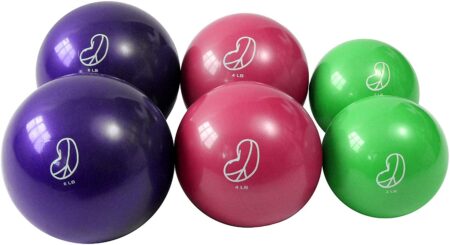
All of these different types of sensory balls are a little unique in their own way and can be helpful, but we’ll be focusing on the classic therapy/yoga ball in this post.
What Are Sensory Balls Used For?
In this post, we’re taking a sensory angle to the therapy or sensory ball, although depending on the activity, your child can also be working on core strength at the same time!
From a sensory standpoint, therapy balls can be used in three primary ways:
- To give your child the sensations they’re seeking! That’s the active and often labeled “wild” kids that have big proprioceptive and vestibular needs. By using the sensory ball, you’re giving your child deep sensory processing input that can help calm and regulate them.
2. Help desensitize your child to movement if they are scared to have their feet off the floor and have a vestibular sensitivity. Approaching the sensory activities slowly and letting them get used to using the therapy ball over time can help improve their sensory processing and decrease that sensitivity. Learn more about sensory sensitivities.
3. Strengthen bilateral coordination skills and crossing the midline of their body. Both of these are higher level sensory skills that parents aren’t taught to look for, but it they’re underdeveloped, it can have an effect on their learning and motor skills.
7 Therapy Ball Activities That Give Awesome Sensory Input
Can you tell that I think the therapy ball is a powerful sensory toy for kids? And by “kids” I do mean, all kids. Whether your child has sensory needs or not, this encourages their development in a big way, even though it looks like you’re just having fun!
Of course, these activities are especially helpful for kids with sensory needs big or small.
And, no matter what types of sensory activities your child likes or doesn’t like, it’s critical that you NEVER force any of these activities. If they’re hesitant, it could be the timing, maybe they’re distracted or tired? Or, maybe the sensory input is too strong for them?
If the latter is the case, then make sure you take it slow.
You can do that by taking any of the activities below and breaking them down into smaller steps they’re comfortable with. If you’re kid is game though, go for it. Here are 7 different ways to use that therapy or yoga ball:
1. The SteamRoller: Have your child lay face down on a carpet floor, or use a mat/thick blanket if no carpet is available. Then, starting at their toes, roll the therapy ball over their legs all the way up to their shoulders. DO NOT ROLL OVER THEIR HEAD.
As you roll, press down so that you are squishing them. Ask your child if they like that. Some kids will say “harder”. They’re the kids that love deep proprioceptive input, and you can then press more firmly. If your child doesn’t speak, then watch their reactions closely. Some kids will LOVE this and demand more.
I like to tell them I’m a steamroller smooshing them as flat as pancake.
Once you roll the ball up to their shoulders, roll it back down to their feet and repeat. If your child is bigger and likes a lot of input, you can even lay across the top of the ball to squish them with all your body weight. Again, make sure your child is comfortable with that weight and continually check on them.
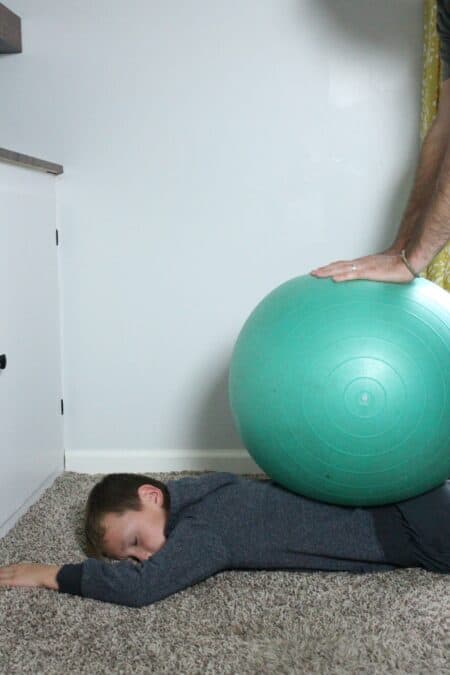
2. Make a Cross and an X: Have your child sit on top of a large enough ball so that their feet can’t touch the floor. Put your hands on their hips to help stabilize them. Then, slowly but steadily, push the ball backwards, away from you, then towards you. Next, move them from side to side. If you were looking from the top, you’d have drawn a plus sign or cross on the floor with the ball.
This activity gives lots of vestibular input and hopefully your child is adjusting their body as you move the ball in different positions so they keep their balance.
Then, you can make an X with the ball moving it diagonally.
If you’re child holds their balance well, try these motions while holding on to their thighs, right above the knee, instead of their hips, and then even more challenging, holding them by their ankles!
Check out how to do this activity in this quick video:
3. Bouncing Two Ways: Get your child on top of the ball and holding their hips (easiest and most secure), thighs, or ankles again, bounce them up and down on the ball. You can get silly with this, bouncing wildly, which your child may love, but it may also wind them up.
Or, you can bounce them rhythmically while counting or singing a song with a repeatable beat like “The ants go marching 1 by 1…”
The sequential bouncing is usually very calming for kids that seek out lots of movement and proprioceptive input.
Depending on your ball size, your child may also be able to sit on top of the ball and bounce themselves with their feet on the floor!
4. Follow the Trail: Simply pushing a large therapy ball around is a great heavy work activity, that means your child is working for their proprioceptive input. Pushing the ball up the wall is another way to get more sensory while adding a challenge for your child to focus on.
Adding some painters tape to the floor and even up the wall can help make the activity more engaging and give them a visual element to follow, which adds more benefit to this easy therapy ball activity.
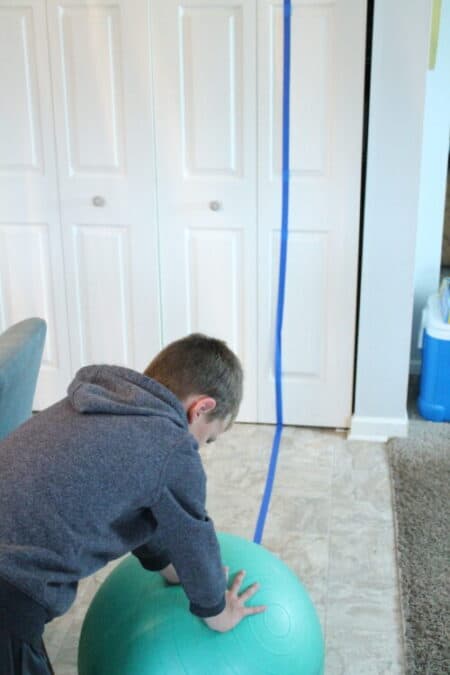
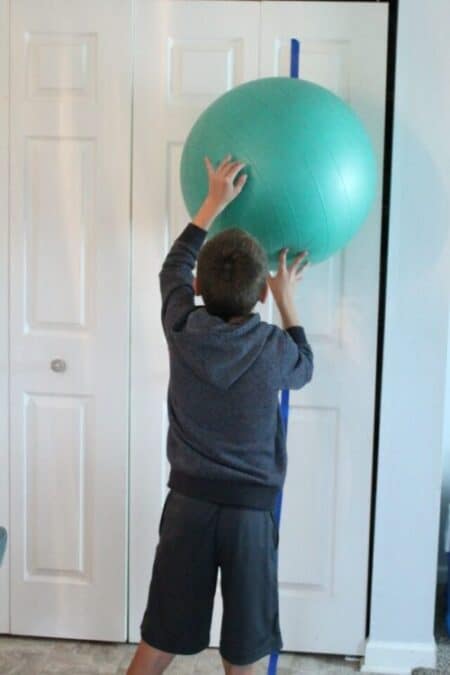
5. Big Kicks and Throws: Find an open space and kick this large ball back and forth with your child or show them how to kick it off the wall so they can do it independently. It will feel sort of silly kicking such a large ball, but it’s a whole different sensation. They’ll get a dose of tactile input too.
And, throwing will not only get them using both hands (hello, bilateral coordination), but you’ll likely get some crossing midline strengthening in there too!
6. The Wheelbarrow Walk: For this activity, hold the ball steady while your child lays across the ball on their belly. Then, roll the ball forward until your child’s hands are flat on the ground. If they are nearly vertical when you do this, your ball is too big for this activity!
When your child’s hands are flat on the ground, encourage them to “walk” forward on their hands. As they do, the ball will roll with them until just their feet are hanging on. Once they reach their feet, tell them to roll back before they fall off.
This is an outstanding sensory processing activity. Although it gives lots of propriocetive, vestibular, and tactile input, your child is getting loads of sensory processing.
7. Flipped Over: Bring your child to a sitting position on top of the ball and slowly roll the ball towards you so that they begin to tip backwards. Hold onto their hips or thighs again for that additional security. They should fall all the way backwards so that they’re hanging upside down. This is a boat load of vestibular input.
If your child is scared of heights or being tipped backward, it will take some time for them to be able to tolerate this.
Leave them their for a few seconds and roll them back up. Allow them to repeat, but carefully monitor how they’re responding.
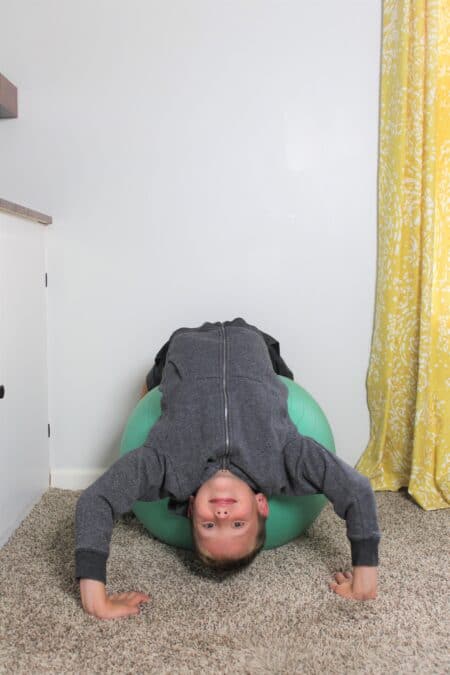
Any of these activities can be done as simply as you’ve read them here, but there’s also lots of ways to add in homework, learning, and other developmental skills to the mix. For instance, you could have a map of the follow the trail route where they find different letters to spell a hidden message or word.
Or, you could have a bucket of bean bags at the end of the wheelbarrow walk so that they grab a bean bag and bring it back to their starting point. Kids love adding these small elements and often they make the therapy ball activity a little more challenging because it incorporates additional skills.
Grab the Free Sensory Printable
If you have a sensory kiddo and are wanting to use these activities as part of a sensory diet, then you’ll want to scoop up this free printable Sensory Diet Printable. This chart will help you get your sensory activities organized, plus track how your child responds and what is actually helpful!
Click here to get the free printable!
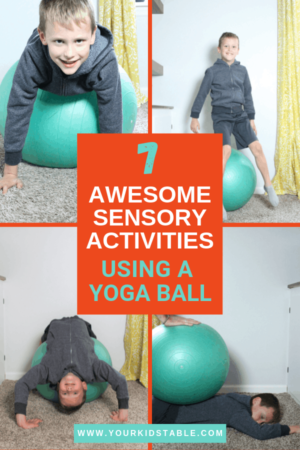
More on Sensory
Ridiculously Do-Able Sensory Integration Activities to Use at Home
Sensory Tricks to Help Your Kid Fall Asleep Fast!
37 Sensory Toys to Help Kids Learn, Communicate, and Calm Down
Alisha Grogan is a licensed occupational therapist and founder of Your Kid’s Table. She has over 14 years experience with expertise in sensory processing and feeding development in babies, toddlers, and children. Alisha also has 3 boys of her own at home. Learn more about her here.
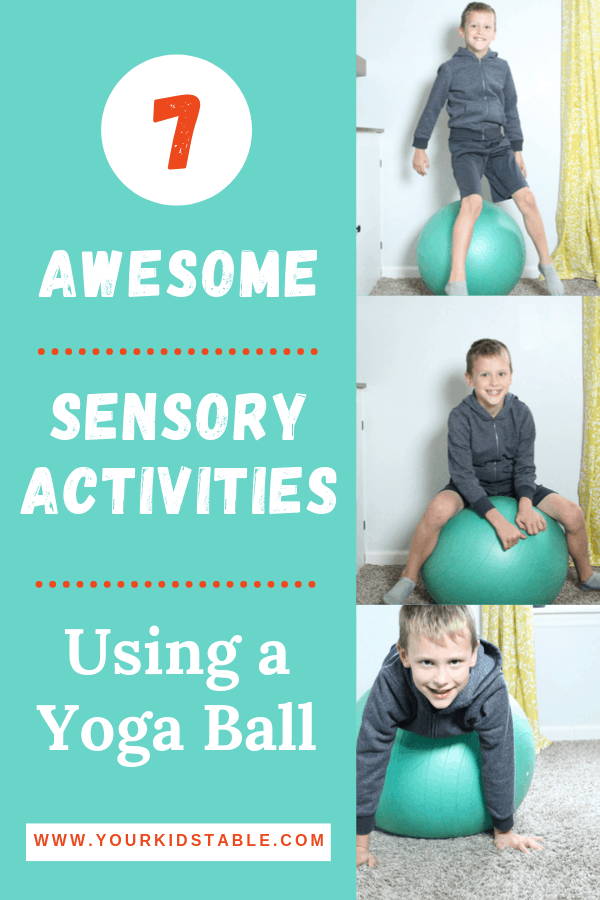
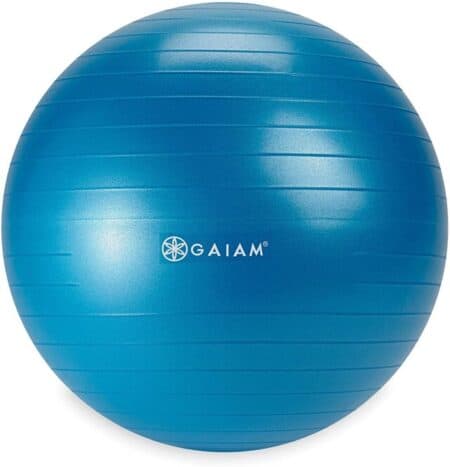
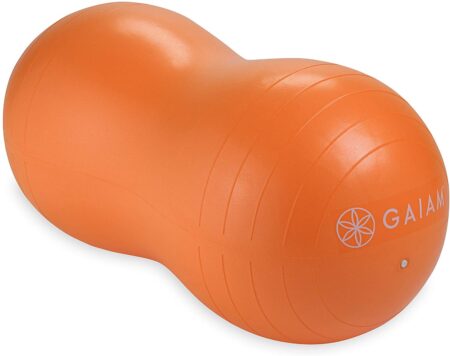
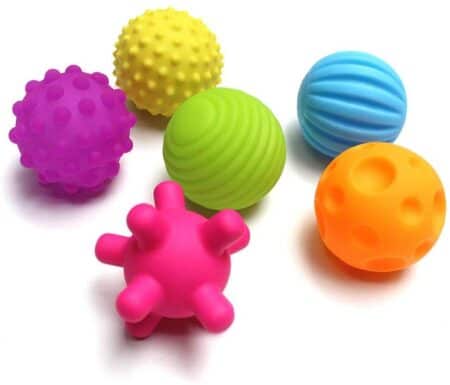
All the information that you shared with us is very useful for us. Thank you for sharing with us.
Hi there! Thank you for your feedback! So glad you found this post helpful.
Best,
Kalyn
Hey.
A quiry about a kid. With multiple disability eg intellectual disability, signs of autism and sever ADHD.
He just doesn’t sit at a place. Doesn’t/can’t communicate, no verbal words.
He likes the stimulation of walking /running, also gets really excited pm loud music and enjoys it…
As he doesn’t understand any sign or verbal language and also can’t stay still, what should be my first goal (and goal oriented activities) for the child should be in order to make him calm.. is it even possible?
Hey Ravita,
Thanks so much for reaching out!! We know how hard it can be to understand what is happening with regards to sensory processing. I would start by understanding sensory with ways to figure out what he is craving when he isn’t calm to find the right activity to help calm him. You can start with our free sensory workshop to learn more about sensory needs, it’ll help! You can save your seat here!
Best,
Desiree
HOW CAN A BALL POP OR BURST
Oh it can. Our ball get a hole from a LEGO cube.
How do you determine what size yoga ball to get for your child. Do you use their height?
Hey Christine,
This will depend on what you are using it for! Generally the average sized one will work as you are helping your child as needed or will work for an older child as well.
Hope this helps!
Desiree
So these exercises would be appropriate for a 15 year old? When he was 8 years old his occupational therapist worked with him on these balancing issues but just for a short period.
Yes, appropriate, I’d try to choose ones that you’d think he may be more interested or try them and see which ones may work for him!
Best,
Desiree
I use the first, steamroller and sixth, the wheelbarow with my 17 old students with ASD and they loved it.
Thank you for sharing
YAY Olga,
Glad they are loving it!!
Would love more activities (big movement) to do inside as winter approaches! My son loves swinging but an indoor swing is not an option.
Hey Jennifer,
I think this article may give you some great ideas! Check it out here!
Best,
Desiree
This is extremely helpful. Thanks for sharing.
Awesome, glad you have enjoyed!
Desiree